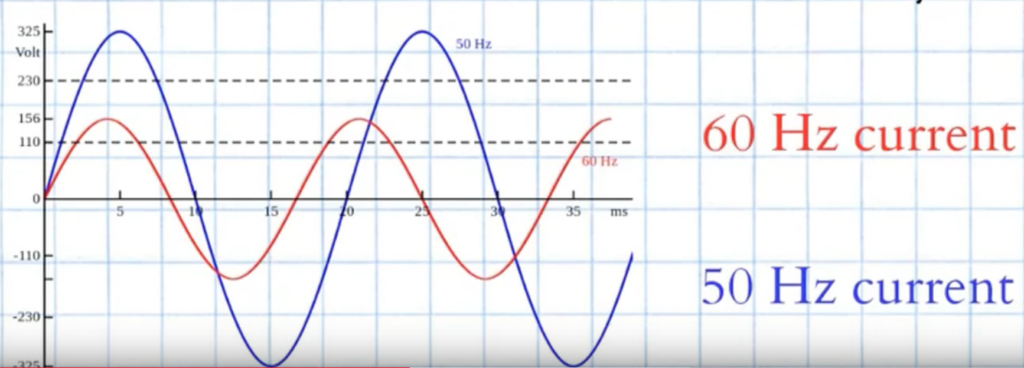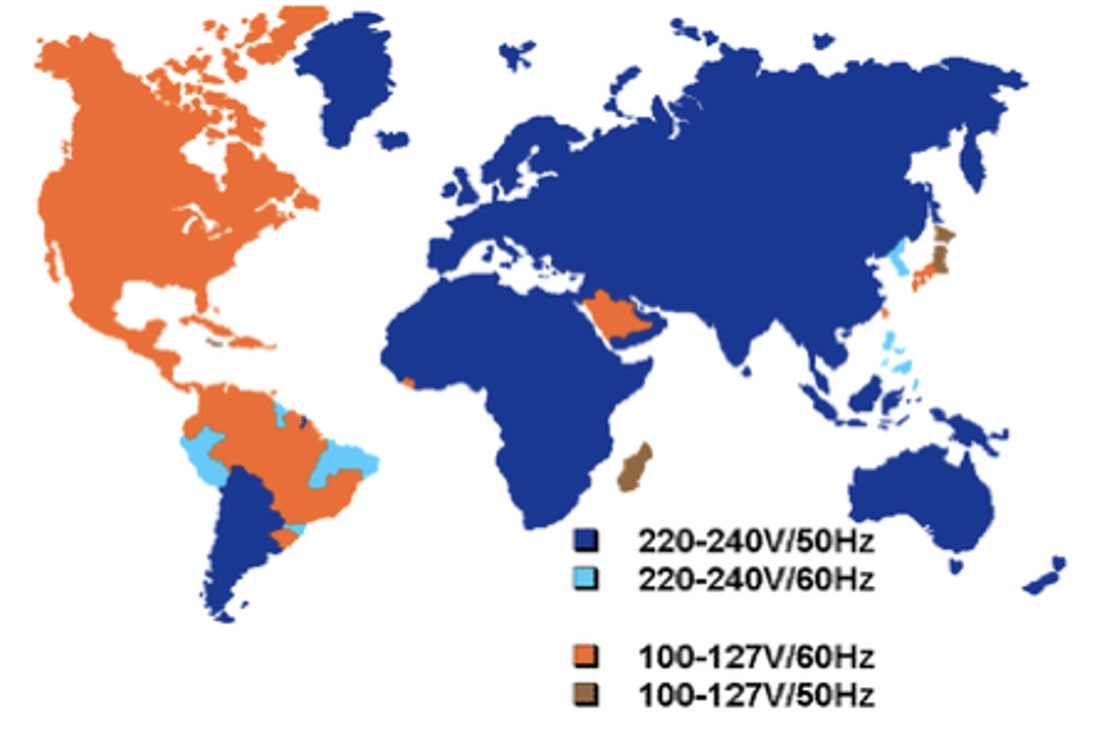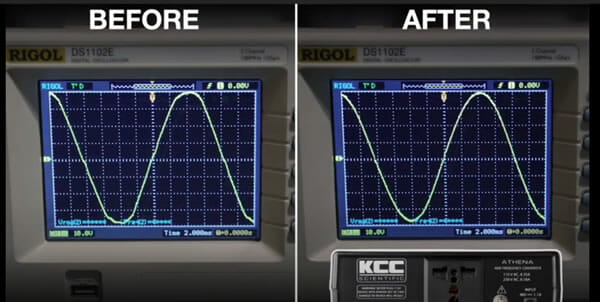Teri Reindel, March 13, 2019
How do you power your valued electronic devices in the new country?
You are a global citizen. Everything today has gone global from the economy to satellite TV. The exception to this globalization is the electrical power grid. Whether you’re moving from North America to another region or vice versa, you could be faced with the issue of mains power line differences when trying to power your electrical or electronic devices. In the new country, the voltage and frequency power standards may be very different from what you are using today.
In North America, as you can see below, the standard mains power is 115V AC at 60Hz. Outside of North America; the standard is 230V AC at 50Hz.

There are exceptions of course, such as Japan, where there are multiple frequency standards. In fact, the electric frequency is different on either side of the Fujigawa River in Shizuoka Prefecture and Itoigawa City in Niigata Prefecture, with 50Hz in the east and 60Hz in the west. To make matters more interesting, Japan operates with 100V AC mains voltage. Most important, for global citizens taking their valued electronics, simply using plug adapters are NOT always enough!
Clarifying Power Converter Terminology
Perhaps you are moving overseas for a temporary assignment that could last several years. You are taking your valued electronics, like high-end audio, perhaps a clock, a recovery boot kit, or professional-grade salon clipper. You are worried about plug compatibility between your prized electrical devices and what’s available in the country you plan to visit. What will you do about your plug-in devices once you arrive there?
One thing is for certain; electrical compatibility is about more than just the plug styles! The commonly available plug adapters won’t be enough if your electric device needs a different voltage and frequency than what will be available in the new country. It might be good to do a brief refresher on the topic!
Somewhere on your device there is probably a tag that indicates the required voltage for the device. It’s not always in an obvious place. It might be in small font, and perhaps less than legible. If you cannot find it, do a quick Google search on the device’s model number and look for the specifications. A quick glance at the tag or the specifications, and you are sure to find the ratings, in a format similar to this example:
Power Requirement: 115V AC, 60Hz, 25W
What does the above rating mean? This is the voltage, frequency and power your device needs to operate properly. Lets look deeper.
Voltage. The first item listed is the voltage, which in this case is 115V AC. The issue most of us are familiar with is Voltage, often abbreviated Volts, or simply “V.”

Every plug-in device will be AC (alternating current) rated. Voltage is the potential difference present at the power plug terminals, which is what causes power to be delivered to your prized device. Some devices will indicate 90-250V AC, which means that your device is “Universal” and can work on any voltage standard across the globe. But, many will not be universal. If the voltage is too low your device will not activate. If the voltage is too much your device will very likely be damaged.
In general, the way the world is divided with respect to voltage is as follows:
North America: 115V AC
Rest of the World: 230V AC
Some exceptions do exist. For example, Taiwan is 115V AC, as is Venezuela, Ecuador and Colombia. So, it is best to check!
Frequency. The next term in the rating is the intended Frequency for the device. Frequency is the number of times that the electric current switches polarity per second, expressed in a standard called Hertz, or abbreviated Hz. On electronics with motors that turn or vibrate, frequency will determine the speed at which they operate. Some devices will indicate 50/60Hz, which means it can operate at either 50Hz or 60Hz and perform well. However, many devices are designed for only 50Hz or only 60Hz, but not both.

Again, the way the world is divided with respect to Frequency is as follows:
North America: 60Hz
Rest of the World: 50Hz
Again, some exceptions exist. Taiwan is 60Hz, as is Venezuela, Ecuador and Colombia. Half of Japan is 50Hz and the other half is 60Hz. So it is always prudent to check!
To check the voltage, frequency and plug type for the country you are traveling to, click here: https://www.worldstandards.eu/electricity/plug-voltage-by-country
Power. The last term in the rating is the power the device requires to do its job, expressed in Watts. When you go to select a power converter, you will need to know this since the power converter must be able to deliver this much power, or more. If the converter does not have a rating greater than this number, then it will not reliably operate your prized device. For instance, your hair clippers require 30 watts of power. You will need a power converter that provides at least 30 watts; perhaps 40 watts or more.

Plug Adapter, Transformer, or Frequency Converter?
Plug Adapters. These enable you to plug into an outlet with a different shape or a different set of prongs. That’s all they do, and no more.
If the country you are traveling to has the same voltage and frequency standard as the devices you own, but the shape of the plug is different, then a plug adapter may work. An example is traveling from your home country in the UK to most European countries, where the plug style in the UK is BS1363 and the standard in Europe is the “Europlug” or Schuko. Here, a plug adapter is completely appropriate since both locations utilize the same mains power standard of 230V AC at 50Hz. But, traveling from the USA to the UK will require more than a plug adapter, since the mains power standard in the USA is 115V AC at 60Hz vs. 230V AC at 50Hz in the UK. And, pay attention–some devices will ALSO require frequency conversion, since the USA standard is 60Hz whereas the UK standard is 50Hz.
Transformers and Voltage Converters. Thus, when the voltage in your home country (and that needed to operate your devices) differs from the voltage where you are planning to travel or relocate, then plug adapters are not enough. When you are moving from North America, your 115V AC electric devices can be severely damaged by the higher 230V AC mains power in other countries. If you are moving to North America, your 230V AC hair dryer or curling iron simply won’t operate on the lower 115V AC voltage. You need a transformer to convert the voltage coming from the outlet from 115V to 230V AC or from 230V to 115V AC depending on which way you are traveling across the globe and what voltage your electrical device requires.
For the most part, personal items that heat, like curling irons and hair dryers can be powered converting only voltage with the use of transformers or voltage converters. But be careful. Curling irons and hair dryers consume a GREAT DEAL of power, and it is very challenging to find a reliable voltage converter or transformer that will perform without overheating with these particular items. Some curling irons or hair dryers may be universal and have switches for selection of 115V or 230V AC, often they don’t. The good news is that most brands of curling irons and hair dryers are readily for sale, with the proper voltage, across the globe. You can store your home-based curling irons or hair dryers for when you are back to your native country.
Summary: Transformers convert voltage only; eg, 115V AC to 230V AC, or 230V AC to 115V AC. But they leave frequency unchanged!
Frequency and Voltage Converters. If you’ve read this far, then by now you know equipment designed to uniquely operate in one part of the world may not be compatible in another. Perhaps you may have purchased a “travel converter kit” made up of conversion plugs and maybe a budget transformer, which converts the voltage (although possibly inadequately). You now understand voltage compatibility, so you dare not plug a device designed for use in North America into an outlet in another part of the world!
You embark on your trip and think everything will be fine until you get there and plug in your hair clippers or clocks, perhaps using the little transformer in your kit. You find that your salon-grade clippers make a frightening noise, grind and don’t work. In this case, frequency (50Hz or 60Hz) as well as the voltage difference BOTH need to be considered between countries! How were you to know you needed to convert frequency as well as voltage?
“Frequency AND Voltage converters convert Voltage from 115V AC to 230V AC or 230V AC to 115V AC and ALSO convert frequency from 50Hz to 60Hz or 60Hz to 50Hz.”
As a general rule, devices that have turning or vibrating motors may have frequency sensitivity. These types of appliances when used at the wrong frequency will pitch, make noise, buzz, run at the wrong speed, or have timekeeping problems. In some cases, devices with motors may malfunction as well as overheat if operated from the wrong frequency. The solution is to procure a frequency (Hz) and voltage (V) converter with the proper power (Watts). For solutions visit KCC Scientific LLC and explore their products.
As a more complex example, a model railroad train set designed for use in the United States will have a 115V AC 60Hz power requirement. If the system’s train transformer is run in Europe with a step-down transformer alone (converting only voltage from 230V to 115V AC at a 50 Hz), it may not operate as intended. The transformer, when operated at the lower frequency may begin to “saturate.” To compensate for this, it’s often recommended that the voltage into the train transformer be lowered perhaps 20% (to about 95V AC or so). Unfortunately, this leaves insufficient power to drive the locomotive and accessories, leading to numerous malfunctions. If this recommendation is ignored, eventually the transformer may overheat due to operating at 50Hz instead of 60Hz. The step-down transformer alone, which only converts voltage, will be insufficient.
For the above model railroad example, consider Thor for systems under 100 watts, and Hercules for systems up to 200 watts.
Another very striking example is the plug-in electric clock and flip clock. If a 60Hz electric clock is plugged into a UK or European outlet with a voltage transformer alone, the clock will lose 12 minutes for every hour! That makes the clock completely unusable. The answer is the super high-precision frequency and voltage conversion provided by compact and affordable Chronos.
So keep this simple rule in mind. For powering your valued electrical and electronic devices across the globe, it’s safest to convert both voltage AND frequency. If you have questions about powering a specific device worldwide, please feel free to contact us. Or, visit our blog for solutions to powering, audio, vintage audio, clocks and flip clocks, clippers, fans, medical equipment, industrial tools and electronic appliances across the globe.
Visit our products to explore frequency and voltage converters up to 200 watts.
We make every attempt and effort to ensure the information on this website is accurate and reliable. We are not liable for any errors, financial loss, or damages of any kind that may result from use of, or reliance on, the information herein, and/or on this website.







